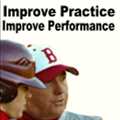Footwork
Tips for Coaching Young Catchers
By Chip Lemin
Hey Coaches,
The season is here. Let's get some last minute catching tips
for you to check out.
Catchers can use two different types of stances. When there
are no runners on base, you assume a position where you have the weight on the instep of your foot. The other stance is with
two strikes on the hitter, or runners on base. Both stances are quite similar, the major difference is preparing to block
pitches at certain times.
With the bases empty, and less than two strikes on a batter,
the catcher should have their weight on the instep of the foot. To prevent the catcher from falling forward, and get caught
lunging at pitches, they should have a strong center of gravity. The left foot should be slightly ahead of the right foot
for a right-handed catcher. Weight should be evenly distributed over both feet to maintain balance. This positioning will
allow you to shift in any direction without trouble.
The catcher's elbow should be resting slightly outside the
knee. The fingers should be pointed up and relaxed along with the glove arm. The fingers in their glove should never be horizontal.
The most important aspect of their throwing arm is to keep it protected. When there are no runners on base, keep the throwing
hand behind the back or the leg. Even without runners on base, they must keep their intensity for a whole game. Catchers must
be ready for all situations, without a lapse in concentration.
When there are two strikes on a batter, or runners on base,
the throwing hand must be moved to behind the glove. There will be no change in weight, foot placement or throwing arm placement.
Put the throwing hand into a fist behind the glove. Their hand is safe behind the glove as all foul balls will change directions
and miss the hand. Keep the hand closed behind the glove as you catch the baseball, this will also protect the hand. The biggest
benefit of keeping the hand behind your glove is being able to begin a quicker exchange to the ball when they need to throw
out a runner. Keeping the throwing hand behind the back hinders a quick throw, and could affect a balanced position.
A common mistake young catcher's make is to move up into a
more athletic position when runners are on base. Moving up into this position also raises the glove into a higher position.
This higher more athletic position actually creates more openings for the baseball to get by the catcher. This higher target
also encourages the pitcher to throw the ball up in the strike zone, which may produce unwanted results. To keep balls from
getting past the catcher, the rule should be stay as low as you can.
Stay focused and intense, stay low, be ready to block all
pitches, and be ready for any situation. Young catchers also like to take too many steps when they throw to bases. They feel
they do not have the arms strength to get the ball to second base. A quick accurate throw by using proper footwork, is often
more beneficial and productive than a late strong inaccurate throw. It takes practice for a catcher to believe that a simple
drop step, and foot shift, will provide everything they need a strong accurate throw.
The catcher is the cornerstone of an exceptional defense.
Your team must have an above average catcher to be considered a special team. Make sure to work in a solid backup catcher
also. Resist the urge to not to teach your catcher another position. It is your job to keep them from becoming one dimensional.
It will also give them a needed break late in the season.
Coach Chip
|
Chip Lemin has been a promoter of youth baseball since they started using aluminum bats. That's
a long time. I have witnessed many good people get into coaching without solid coaching skills and it is not fun for them
or the kids.Today's newer coaches are also being shortchanged on sportsmanship, like there is none. Visit my site to sign
up for a insightful, informational, free coaching e-course at http://www.baseballecourse.com
Article Source: http://EzineArticles.com/?expert=Chip_Lemin |

